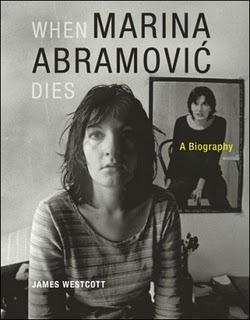When Marina Abramović Dies

As someone with only one semester of art history under my belt, I find myself both interested and intimidated by the politics and practice of performance art. After reading this exhaustive biography of performing art legend Marina Abramović (who just wrapped up a stunning retrospective at the Museum of Modern Art in New York), my intimidation has been replaced by a strong desire to see Abramović’s work.
When reading about an iconic figure such as Abramović, the private aspects of her otherwise very public life are the most interesting artifacts to glean. Through complete cooperation from Abramović and many of her friends and family members, James Westcott produces a marvelously comprehensive history of the artist's childhood in Yugoslavia and the beginning of the career that would revolutionize the use of the body as an artistic vehicle in the 1970s. The downside of writing about such an icon is that, while there is no shortage of fascinating material, one must organize it in such a way as to not overwhelm the reader. Westcott does just that, dividing Abramović’s life into three distinct parts: her early years, her work with fellow performance artist and former romantic partner Ulay, and her recent foray into solo performances.
For readers familiar with Abramović’s body of work, the book will most likely open your eyes to some of her earliest projects, and will offer interesting insight into her more famous pieces. One such example is her 1975 performance of Rhythm 0, where she laid out seventy-two items for museum patrons to use on her however they wished. These items included a loaded gun, which a man put in her hand and pointed at her neck. The author seamlessly weaves together interviews, archival photo footage, and factual information to make Abramović’s life as vibrant on the page as it is in reality.
Above all, Westcott proves to be an incredibly detailed biographer. Near the end of the book, readers understand where some of this attention to detail stems from; he recently served as a transcriptionist for some of Abramović’s marathon performances, writing hundreds of pages at her insistence to describe her hours of sitting or standing during certain pieces. The result of Westcott’s well-researched writing style and Abramović’s openness and commitment to storytelling and making art, When Marina Abramović Dies becomes an enthralling look at the world of performance art, a strong-willed and endlessly creative woman, and what happens when those two things collide for over forty years.